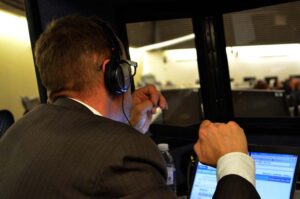
Why use translation equipment?
In situations in which an audience consists of speakers of multiple foreign languages, using translation equipment is the most effective way for interpreters to communicate the presenters’ messages to the audience in their own language. This kind of equipment is used in situations such as United Nations meetings and international business conferences.
What is translation equipment?
Translation equipment has multiple components. The interpreter will need a headset connected to the presenter’s microphone. In addition, the interpreter needs his/her own microphone, which will transmit the interpreted speech to the audience members who have individual receivers and headsets.
- Know the Two Types
There are two basic types of simultaneous interpretation equipment: Infrared transmission and radio transmission.
The benefits of Infrared transmission are its immunity to radio interference and its shorter range (good for high-security situations). Drawbacks are the need for professional installation and its shorter range (bad for large events).
The benefits of radio transmission are their larger ranges of transmission and their simplicity. Depending on the frequency, FM transmissions can reach 1,500 to 3,000 feet, and anyone can easily install these systems. The main negative of FM is its susceptibility to interference from other radio signals. FM-based equipment is much more commonly used than Infrared-based equipment.
- Which Equipment to Use?
Determining which type of equipment to use, along with which companies to buy or rent from, primarily depends on how it is planned to be used: the size of the audience, the number of desired languages, the size and setup of the venue, and the type of presentation to be given.
Again, FM radio transmission is more appropriate for larger venues and more listeners while Infrared specializes in avoiding interference and is more appropriate in small venues. Within these two categories, there are many available options from a variety of providers, so factors like cost, range, audience size, and sound quality all should factor into the decision.
- Don’t Leave Any Equipment Behind
The interpreter must be equipped with a variety of equipment, including a transmitter, a headset, and a microphone. Usually, the interpreter will also require a control console and XLR cables to manage their connections. These materials should all be located in the place in which the interpreter will work during the event. A separate set of these materials will be needed for each additional language.
The audience members who require the interpretation will each need their own receiver and headset. Their receivers should be synchronized with the channel of the interpreter working in their language.
- Location, Location, Location
The ideal working location for a simultaneous interpreter is a soundproof booth within view of the presenter and any related visuals. If a booth is not available, a table or other private space can do. The space should be secluded and should be able to comfortably seat 2-3 interpreters. A work surface is required, along with lamps or another source of light if the venue will be dark.
- Fluency is Key
An interpreter has an extremely demanding job to do. Simultaneous interpreters must have complete confidence in their language abilities, and they must be very comfortable with both the languages. Because live events are unpredictable, a simultaneous interpreter must be able to improvise and think quickly in both languages.
Comprehensive knowledge of the language itself is not the only requirement to being an effective interpreter. They must have a thorough understanding of the cultures that exist within each language, including tone, body language, and idioms.
- Work in Pairs
Again, simultaneous interpretation is an extremely demanding job, and it requires persistent focus and concentration. Anyone doing a job so mentally exhausting will get tired, and this can lead to critical mistakes in interpretation. To ensure they remain focused and mentally sprightly, many interpreters switch off with an alternate every 15-30 minutes. During their off-time, alternate interpreters can rest and take a short break to refocus themselves and ensure they will be able to provide quality interpretations of the presenter’s words.
- Prepare!
Prior to the event, collect as much information about the content of the event as possible. Try to obtain all Power Points, handouts, and outlines. These materials will provide a good idea of the topics to be discussed and can help you to prepare to use the appropriate vocabulary in each language. If no printed materials are available, try to determine the content of the presentations through other means as much as possible. And this leads to our final tip…
- Meet with the Presenter
Meeting with the presenter prior to the start of the event can prove extremely helpful. It is important that they understand the nature of simultaneous interpretation. In addition, this type of meeting can help you to be more prepared for the content of the presentation. Finally, it can often provide ease of mind for the presenter to know who is responsible for the communication of his words to part of the audience. This can seem especially daunting to a presenter when the interpreter is located out of sight, such as in an adjacent room or secluded sound-proof booth.
Do you have any additional tips on working with simultaneous interpreters? Please join the conversation in the comments below!






